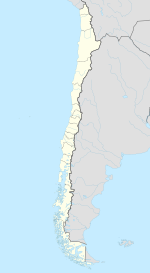El Quisco
| El Quisco | |||||
|---|---|---|---|---|---|
| Commune | |||||
|
|||||
| Coordinates: 33°23′28.71″S 71°41′34.58″W / 33.3913083°S 71.6929389°WCoordinates: 33°23′28.71″S 71°41′34.58″W / 33.3913083°S 71.6929389°W | |||||
| Country | Chile | ||||
| Region | Valparaíso | ||||
| Province | San Antonio | ||||
| Government | |||||
| • Type | Municipality | ||||
| • Alcalde | Natalia Carrasco Pizarro | ||||
| Area | |||||
| • Total | 50.7 km2 (19.6 sq mi) | ||||
| Elevation | 13 m (43 ft) | ||||
| Population (2012 Census) | |||||
| • Total | 11,329 | ||||
| • Density | 220/km2 (580/sq mi) | ||||
| • Urban | 8,931 | ||||
| • Rural | 536 | ||||
| Sex | |||||
| • Men | 4,815 | ||||
| • Women | 4,652 | ||||
| Time zone | CLT (UTC-4) | ||||
| • Summer (DST) | CLST (UTC-3) | ||||
| Website | www |
||||
El Quisco is a Chilean city and commune in San Antonio Province, Valparaíso Region. Located in the country's central coast, it serves as a popular summer resort for the population of Santiago and forms part of the Coast of Poets, a cultural space named for four Chilean poets of world renown: Pablo Neruda, Vicente Huidobro, Violeta Parra and Nicanor Parra. A place of interest is La Casa de Isla Negra, the former house of Chilean poet Pablo Neruda, now his burial place and a museum.
The Quisco has had a major development in the 20th century but few ones know his past.
A characteristic little known about this resort is that there have been important archaeological findings related to the Período agroalfarero temprano and Período agroalfarero tardío of the coastal zone, in the shape of conchales in the peninsulas, centre and north.
Inside the cultures that occupied El Quisco there were of El Bato and Llolleo cultural areas, which they characterized to the Early period, coinciding your ates with those of the Molle culture. In this Periodo agroalfarero temprano - or formative early-, coexistences of populations are distinguished yet of the Archaic Period, with other groups of entail ) northern - Bato tradition -, and others with geographic development more places - Llolleo cultural complex, but located more in the southern part.
Bato Tradition , that is established about them 300 BC and 400, sharing cultural guidelines with the Molle culture which was located more in the northern part. Typical of the above-mentioned culture it was the use of tembetá; in addition they found mortars which are elements of stone used in the grinding of vegetables and minerals. The evidence of the place of this group is in the ex-property in the country Trebulco and in La Manresa, located in the locality of Lonquén. His maximum development reaches towards 400 to 500 both on the coast and in the interior, and persists up to late moments in the Preandean zone towards 900.
...
Wikipedia



